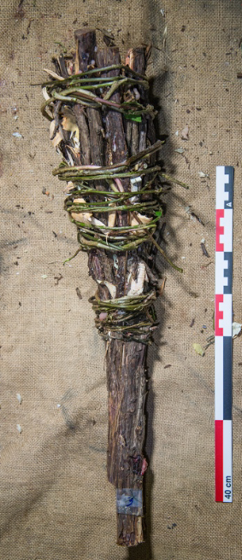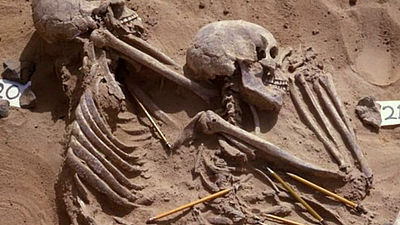What was the torch material used 30,000 years ago?

Although fire, which is indispensable for human life, can be handled freely in modern times, our ancestors used to handle fire by limited means such as bonfires and torches.
The conquest of the dark spaces: An experimental approach to lighting systems in Paleolithic caves
https://journals.plos.org/plosone/article?id=10.1371/journal.pone.0250497
Clever Experiment Reveals How Our Ancestors Used Lighting Sources in Caves
https://www.sciencealert.com/scientists-recreate-three-types-of-ancient-lighting-to-understand-paleolithic-cave-dwellers
Archaeologist Angeles Medina of the University of Cordoba and colleagues are investigating residues such as charcoal and bones from the late Paleolithic cave 'Bruniquel Cave' in France. By collecting various materials in consideration of the vegetation and climate at that time, actually making a fire in the cave and experimenting with usability as lighting, the optimum lighting material for each purpose such as 'search' and 'living' I tried to figure out.
The materials prepared by Medina et al . Are four types of wood, ivy, juniper , oak, and birch , pine, and fat from the bone marrow of cows and deer. Medina and colleagues combined these materials to make five types of torches, two types of lamps, and one bonfire, and actually lit them in a cave suitable for living to investigate the burning time and brightness.
Of the eight types, the one that emitted the strongest light was a torch made from 'dried juniper 772g, dried birch 30g, ivy 50g, and deer fat 60g.' The torch emitted light for 61 minutes with an average illuminance of 21.94 lux . The five types of torches continued to burn for 41 minutes on average and were able to illuminate up to almost 6 meters away, but problems such as a lot of smoke and hitting the ceiling were mentioned.

In addition, although the average illuminance of the lamp made of dried juniper, fat, and pine was as dark as 3.17 lux, it did not emit much smoke and maintained stable brightness for over an hour. The bonfire made of dried juniper and oak reached an average illuminance of 19.2 lux, but white smoke was generated and filled the cave. 'It's important to have a good grasp of the airflow when staying in a cave for a long time,' said Medina and colleagues.

In addition, Medina et al. Investigated 'Can you see the mural painted near the ceiling of the cave with the prepared lighting?' Even if it could be done, it turned out that people standing on the ground could hardly see the mural painting. 'It is believed that the bonfire was calculated and placed to illuminate the entire space. It is clear that torches are the best way to travel the road, and the road to the mural is actually charcoal. It doesn't seem to be a coincidence that there are traces of. '

Related Posts:
in Science, Posted by log1p_kr







